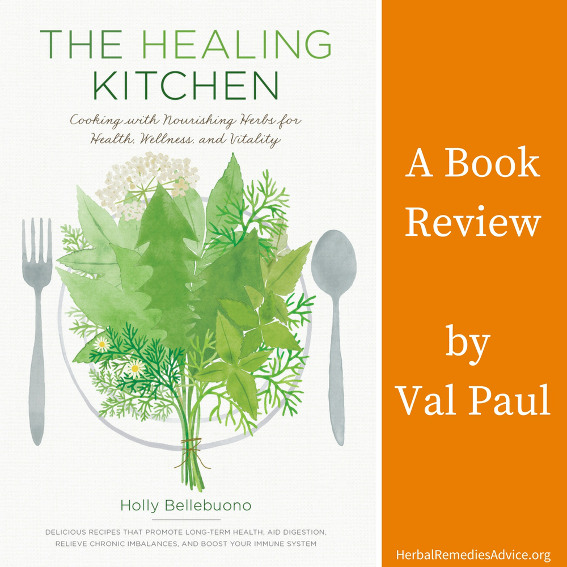Get weekly tips, recipes, and my Herbal Jumpstart e-course! Sign up for free today.

The Healing Kitchen: A Book Review by Val Paul
Share this! |
|
I am always on the lookout for herbal books whose recipes go beyond tinctures. There are several reasons for that. I am passionate about cooking and kitchen remedies, and am often asked about alcohol-free recipes. It is important to me to be able to share my love of plants and resources that help us all incorporate plants into our daily lives so I was thrilled to find The Healing Kitchen by Holly Bellebuono. This herbal cookbook goes way beyond tinctures and is full of recipes—more than 150, of which only two contain alcohol—that are creative and inspiring.
Holly begins by sharing her story and how it influenced her to write The Healing Kitchen. As a maker who isn’t a “kitchen elf,” she wanted to share recipes that are not only delicious but quick and easy. Holly also wanted the book to be a collaborative effort. In addition to Holly’s recipes, there are recipes from many herbalists and chefs, including Rosalee (who also wrote the foreword).
At the beginning of each chapter, each preparation is described with directions and tips on how to prepare, followed by an abundance of recipes. Each recipe also features helpful tips and information on such things as the ingredients, use, and history. Icons denoting benefits are also included with recipes where applicable. The recipe icons categorized by benefit are: energizing, digestive support, heart support, stress support, nourishing, calming, immune support, clarity and memory, refreshing, and iron-rich. There is also a recipe icon index for quick reference. Herbal sidebars are peppered throughout the book for more than 70 of the herbs included in the recipes. These sidebars describe the herb and its benefits. I also adore the emphasis put on starting where you are, regardless of experience.
Let's look at the different parts of the book.
Healthy Additions
In the first part, we begin with “Healthy Additions.” The chapters include gomasio, salts, and spice blends, vinegars, oils, and pestos, herbal butters, infused honey, electuaries, syrups and elixirs. There are takes on classic recipes like Vinegar Of Four Thieves and Sage Butter, and innovative recipes like Yang Vinegar, Mineral-Rich Seaweed Oil, Cinnamon Molasses Spread, Bitters Syrup and, for wildcrafters, an American Allspice Berry Seasoning. The chart for achieving flavor when combining vinegars and oils from the recipes included in this section is very helpful.
Nourishing Drinks
The second part of The Healing Kitchen is all about nourishing drinks. The chapters cover herbal teas, infusions, and decoctions, chai and mulling blends, smoothies and delicious drinks, and herbal milks. This chapter also includes instructions on how to make herbal powders and a chart that covers the flavors and benefits of 14 herbs that are in the smoothie recipes. As a fermenter, I was thrilled to see recipes for kombucha and herbal soda. The herbal milk recipes can be made with dairy-free alternatives for those for whom dairy isn’t a good fit. Recipes for wildcrafters include Sumac Lemonade and Permission Seed Coffee—which I can’t wait to try.
Healing Foods
In part three we move on to healing foods. There are chapters on nourishing breakfasts, snacks, salads, broths and soups, main dishes, and sweet treats. The recipes take into account that there are many different dietary needs. For example, the chapter on nourishing breakfasts includes recipes for yogurt, with charts that describe taste and texture using dairy or almond starter cultures, and include various milk options, like cow, almond, coconut, hemp, oat, quinoa, rice, and soy. Throughout the chapters there are also substitutions for nuts using seeds, a coconut creme dip in addition to a dairy option, and many vegan and bone broth recipes. The snack chapter is one of my favorites in the book. The standouts for me in this chapter are the bread and cracker recipes because of the use of so many different seeds like plantain, nettle, lamb’s quarter, amaranth, chia, flax, and millet. The cracker recipes are also gluten free, which is a bonus. The salad chapter features a varied array of greens, beans, and herbs. The broths are lovely and can also be used in some of the recipes included in some of the main dishes. Grains and greens are stars in the chapter on main dishes. Lamb’s Quarter Cavatelli, Nettle Ravioli, and Wild Green Sauté with Polenta and Poached Egg are a few examples. I would be remiss not to mention some of the sweets, which include ice pops, shortbread, jelly, jam, and even candied fennel seeds—yum.
Summary for The Healing Kitchen
The Healing Kitchen is a great addition to any kitchen cookbook collection and herbal library. You will have a myriad of ways to incorporate plants into your diet at your fingertips and will increase your knowledge and connection to the plants as you create nourishing foods.
The Healing Kitchen: Cooking with Nourishing Herbs for Health, Wellness, and Vitality
Holly Bellebuono
Roost Books
978-1611802788
256 pages

Rosalee is an herbalist and author of the bestselling book Alchemy of Herbs: Transform Everyday Ingredients Into Foods & Remedies That Healand co-author of the bestselling book Wild Remedies: How to Forage Healing Foods and Craft Your Own Herbal Medicine. She's a registered herbalist with the American Herbalist Guild and has taught thousands of students through her online courses. Read about how Rosalee went from having a terminal illness to being a bestselling author in her full story here.
